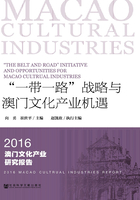
Preface Three “The Belt and Road” Initiative and the Opportunities of the Macao Cultural Industries
The Forum on Cultural Industries(Macao)was co-founded in 2015 by the Chinese Cultural Exchange Association and the Institute for Cultural Industries of Peking University, with the support of the Macao SAR government and all circles of the society. On the basis of Macao's unique cultural heritage of both Chinese and Western culture, and by means of Macao's special geographical and institutional advantages, the forum assembles experts and scholars from mainland China, Hong Kong, Macao, Taiwan and other parts of the world to work out solutions for the cultural innovation and industry development of Macao.
Under the theme of“‘the Belt and Road' Initiative and the Opportunities of the Macao Cultural Industries”, the Forum on Cultural Industries(Macao)2016 explored how Macao should seize the opportunity of “the Belt and Road”(B&R)initiative to accelerate the development of its cultural industries and promote the proper and diversified development of its economy. B&R refers to the Silk Road Economic Belt and the 21-Century Maritime Silk Road. As a related initiative to China's geostrategy, multilateral strategy and global strategy, B&R will exert a far-reaching influence on China's politics, economy, society, culture, ecological civilization and many other fields.
In 1877, German scholar Ferdinand Richthofen named the trade route from China to Xiyu(the West Regions)and Central Asian countries the “Silk Road”. It had lasted for nearly 2000 years before it declined due to the rise and rapid development of the maritime Silk Road in the latter half of the Ming Dynasty. And it is commonly accepted among scholars that the Silk Road consisted of four main routes.
The first was the prairie Silk Road, a relatively flat and dry steppe zone across Siberian coniferous forest and Northern Mongolian Plateau. It extended east to west from the Greater Khingan Mountains through northern Mongolia grassland, the Kazakh Steppe, the southern Russian steppe, to the Danube.
The second was the oasis Silk Road located to the south of the prairie Silk Road, which linked up scattered towns and oases in East, Central and West Asia.
The third was the southern Silk Road, referring to the north-south road network that connected the Hexi Corridor and the Longzhong, Longnan and Hanzhong areas of Gansu province in the north to the Qinghai, Sichuan, Xizang(Tibet), Yunnan and Guizhou provinces in the south to the South Asian subcontinent and the Indochina Peninsula.
The fourth was the maritime Silk Road. Residents in different areas extended their reach along the coastline of the Asian continent, and gradually created a maritime network covering the Western Pacific, the South China Sea, the Indian Ocean and the Red Sea.
Since the prairie Silk Road was too old for historical relics to remain till today, and the Maritime Silk Road was hard to approach, prior academic research mostly focused on the oasis Silk Road.
These four Silk Road routes, namely the ancient Silk Road, were the results of the first globalization movement driven by China during the agricultural civilization period. The Silk Road was an important channel of Sino-Western trade. It enabled the leapfrog development in both business activities and cultural exchanges, and brought a diversified pattern of cultural fusion. All this gathered new momentum for the innovative era.
The human society went through the Industrial Age(the second globalization movement driven by the British Industrial Revolution), the Information Age(the third globalization movement driven by the American information revolution), and finally enters a new era of the 21-Century post-industrial economy. After three decades of economic reform and development, China has become the engine for world economic growth. As a part of China's open-door policy and diplomatic strategy, the B&R initiative meets both the internal need of China's economic development and the external need resulted from world's economic imbalance. It is an external chance for China's economic transition and an international opportunity for China's industrial structure adjustment. The B&R initiative means the fourth globalization movement which aims to build a community of common destiny for mankind through open development and win-win cooperation.
As an important hub on the Maritime Silk Road, Macao should seize the opportunity of the B&R initiative, build itself into a global tourism and leisure center, and become a service platform of trade cooperation for China and the Portuguese-speaking countries, so as to achieve the diversified and open development of its own economy. This is also a historic chance for Macao to get involved in the process of economic globalization.
Culture can function as apenetrator, instructor, coordinator or integrator. Therefore, cultural exchange and cultural trade should be treated as important content of the B&R initiative. To participate in the initiative, Macao should also pay attention to related problems arose in the development of local culture and cultural industries, and serve as an exhibition center for traditional Chinese culture and the Maritime Silk Road, an international trade center for Sino-Portuguese cultural products, an innovation center for emerging Asian culture and an experience center for international culture. As an important part of the cultural competitiveness, the cultural industries can provide the main impetus to make Macao such centers.
Participants of the forum will explore the implementation paths and development modes of Macao in the realization of the B&R initiative from the perspective of cultural industries. These topics are of vital and practical significance. I look forward to hearing their valuable opinions in the forum.
April 19th,2017
